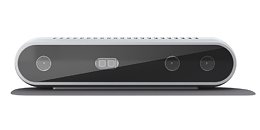Friday, January 19th 2018

Intel Now Shipping Their RealSense D400 Depth Cameras
Today, Intel began shipping two new Intel RealSense D400 Depth Cameras from the next-generation Intel RealSense D400 product family: the D415 and D435, adding 3D capabilities to any prototype development or end user-ready device or machine.
Ideal for makers and educators as well as hardware prototyping and software development, the new depth cameras come in a ready-to-use, USB-powered form factor that pair with a D400 depth module, a turnkey optical depth solution, and the new Intel RealSense vision processor D4 for processing complex depth data in real time. Supported by the Intel RealSense SDK 2.0 - available for the first time as a cross-platform, open source SDK - the cameras can also be used both indoors and outdoors and in any lighting environment."Many of today's machines and devices use 2D image recognition-based computer vision, but with Intel RealSense's best-in-class depth technology, we are redefining future technologies to 'see' like a human, so devices and machines can truly enrich people's lives," said Sagi Ben Moshe, vice president and general manager of the RealSense Group at Intel. "With its compact, ready-to-use form, the Intel RealSense D400 Depth Camera series not only makes it easy for developers to build 3D depth sensing into any design, but they are also ready to be embedded into high-volume products."
As applications for a range of computer vision uses advance across VR/AR, robotics, drones and more, adding new levels of depth for real-time feedback will make devices significantly more intelligent and enable new experiences. With the Intel RealSense Software Developer Kit that features the Intel RealSense viewer, developers, OEMs/ODMs and system integrators are unlocking new depth data with access to the depth camera to tackle everything from viewing the depth stream, visualizing 3D point clouds recording and playing back streams to quickly configuring multiple cameras together and calibrating cameras.
The Intel RealSense D400 product series, including the new D415 and D435 Depth Cameras, are available now for order.
Ideal for makers and educators as well as hardware prototyping and software development, the new depth cameras come in a ready-to-use, USB-powered form factor that pair with a D400 depth module, a turnkey optical depth solution, and the new Intel RealSense vision processor D4 for processing complex depth data in real time. Supported by the Intel RealSense SDK 2.0 - available for the first time as a cross-platform, open source SDK - the cameras can also be used both indoors and outdoors and in any lighting environment."Many of today's machines and devices use 2D image recognition-based computer vision, but with Intel RealSense's best-in-class depth technology, we are redefining future technologies to 'see' like a human, so devices and machines can truly enrich people's lives," said Sagi Ben Moshe, vice president and general manager of the RealSense Group at Intel. "With its compact, ready-to-use form, the Intel RealSense D400 Depth Camera series not only makes it easy for developers to build 3D depth sensing into any design, but they are also ready to be embedded into high-volume products."
As applications for a range of computer vision uses advance across VR/AR, robotics, drones and more, adding new levels of depth for real-time feedback will make devices significantly more intelligent and enable new experiences. With the Intel RealSense Software Developer Kit that features the Intel RealSense viewer, developers, OEMs/ODMs and system integrators are unlocking new depth data with access to the depth camera to tackle everything from viewing the depth stream, visualizing 3D point clouds recording and playing back streams to quickly configuring multiple cameras together and calibrating cameras.
The Intel RealSense D400 product series, including the new D415 and D435 Depth Cameras, are available now for order.


3 Comments on Intel Now Shipping Their RealSense D400 Depth Cameras
Support was lacking at best, but they were slowly picking up interest.
Until Intel out of nowhere pulled the plug leaving everyone using their embedded solutions desperately scrambling for alternatives. :mad:
On topic: Not many people see this field as an important one but the development of depthsensing cameras will define the technology we will be implementing the next 20 years or so by allowing robots and solutions to understand and perceive our world the way WE do it, brigding two very different paradigms of understanding together and enabling context awareness to implemented not only as a peripheral thing.